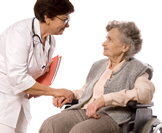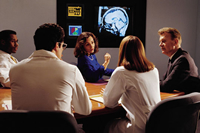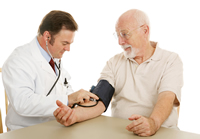After Stroke

This page provides general information on what happens after a stroke. Please talk with your healthcare team for more detailed information.
What Do You Need to Know?

Stroke affects everyone differently. There is no way to predict how much your loved one will recover. Nor is it possible to know how long it will take to recover. The effects of stroke vary from person to person. Some problems may be temporary and will get better with time. Other problems may be permanent.
Stroke-related physical problems can include the following:
- Weakness or paralysis
- Balance problems
- Difficulty speaking
- Pain or numbness
- Trouble swallowing
- Trouble controlling bladder or bowel
- Becoming tired or fatigued
Stroke problems related to thinking and emotions can include the following:
- Memory loss or trouble thinking
- Uncontrollable emotions
- Depression and anxiety
What Treatments Should You Discuss with Your Healthcare Team? 
Treatment will depend on the type of stroke your loved one had. Treatment can include medicines, surgery, hospital care and rehabilitation.
Ischemic Stroke
Ischemic stroke occurs when a clot blocks a blood vessel leading to the brain. This keeps the brain from getting the oxygen that it needs.
To treat, blood flow must be restored quickly to the brain. A medicine called tissue plasminogen activator (t-PA) can be used to break up the blood clot. To work best, it must be given as soon as possible. This is usually within 4 hours after stroke symptoms start. That is why it is important to get medical help right away.
Other medicines are used to prevent a new or recurrent stroke. This will depend on your loved one’s risk factors. It will also depend on the type of stroke. Antiplatelets and anticoagulants are used to keep the blood from clotting. They can also keep existing clots from getting bigger. Aspirin** is a common antiplatelet medicine. Warfarin* or other anticoagulant medicines may also be used.
A carotid endarterectomy may also be performed to prevent a new or recurrent stroke. This surgery removes plaque from the carotid arteries. But, not everyone is able to undergo surgery. A less invasive procedure called an angioplasty can be done. It involves temporarily inflating a tiny balloon inside the artery. The balloon is used to break up the plaque. A mesh tube or “stent” is then inserted. This will help to prevent future blockage of the artery.
Hemorrhagic Stroke
Hemorrhagic stroke occurs when a blood vessel to the brain bursts. This causes bleeding within the brain.
Treatment will depend on where in the brain the bleeding occurs. Hypertension is the most common cause for bleeding in the brain. An aneurysm can also cause bleeding. It is a thin, weak spot in the blood vessel wall. A less common condition is the rupture of an arteriovenous malformation (AVM). An AVM is an abnormal tangle of thin blood vessels.
Medicines are used to treat hypertension and swelling in the brain. If surgery is needed, an aneurysm clipping may be done. A metal clamp is placed on the base of the aneurysm. This is done to prevent rupture or more bleeding. An endovascular coil embolization is a less invasive procedure. It involves guiding a catheter to the aneurysm or AVM. A coil is then placed there to block it off. This is done to prevent rupture. Surgical AVM removal is sometimes done to remove a smaller AVM.
Hospital Care
Your loved one will be hospitalized following the stroke. The healthcare team will monitor him or her for complications. Once your loved one is stable, rehabilitation can begin.
Rehabilitation (Rehab)
The goal of rehabilitation is to make the best possible recovery. Rehab consists of multiple therapies. These can include physical, occupational, recreational and speech therapy. The rehab specialists will educate you about what to expect. They will teach you how to provide the necessary care to your loved one. Learn more about stroke rehabilitation.
Preparing for Discharge from the Hospital
Discharge planning begins in the early stages of hospitalization. It will involve you, your loved one and the healthcare team.
Discharge planning includes:
- Making sure your loved one has a safe place to live after discharge.
- Deciding what types of care your loved one will need. Determining who will provide the care.
- Arranging for outside services, such as rehab or home health.
- Choosing the healthcare provider or team that will monitor your loved one’s health and medical needs.
What Are Common Medical Complications Following a Stroke?
The complications below usually occur over time. They can often be prevented.
Depression – Depression is a mood disorder common after stroke. It causes negative feelings. Depression is a normal response to the losses that occur from a stroke. Seek help from your healthcare team if your loved one is depressed. Learn more about depression after a stroke.
Pressure Sores – Pressure sores happen when “pressure” to parts of the body decreases the blood flow. This can occur from laying or sitting too long. The most common areas for pressure sores are boney areas. These include heels, elbows, hips and the tailbone. Learn more about helping with everyday personal care for your loved one, including preventing pressure sores.
Muscle Spasticity – Muscle spasticity and contractures happen over time. Muscles in the arms or legs shorten and become tight or rigid. Rehabilitation can help prevent painful contractures. It can help maintain as much function as possible. Learn more about spasticity.
Deep Venous Thrombosis – Deep venous thrombosis happens when a clot forms in the veins of the leg. This is due to decreased mobility. If the clot breaks free, it can travel to the lungs. This is called a pulmonary embolism. Elastic stockings can be used to help with circulation. Medicines may also be given to prevent clotting.
How Do You Prevent Future Strokes? 
Monitor blood pressure – High blood pressure is the leading risk factor for stroke. Have your loved one’s blood pressure checked regularly. High blood pressure can be controlled by medicine. Lifestyle changes, like diet and exercise can also help.
Eat healthy and exercise regularly – Being overweight increases your loved one’s risk of health problems. Help your loved one to eat healthy foods and drink plenty of water. Encourage your loved one to exercise regularly. Exercise is important in reducing the risk of another stroke. Learn more about eating healthy and exercising after stroke.
Reduce salt intake – Too much salt can raise your loved one’s blood pressure. Cut back on salty snacks and processed food. Your loved one should have only 2/3 teaspoon of table salt each day.
Drink sensibly – Drinking too much alcohol can raise your loved one’s blood pressure. This can lead to heart disease or stroke. If your loved one drinks alcohol, limit it to no more than one drink per day. One drink equals one 12 ounce beer, one 5 ounce glass of wine, or one 1.5 ounce shot of hard liquor.
Stop smoking – If your loved one smokes, it is important to quit. Stopping now can lower the risk of another stroke. The Resources page has contact information for the American Heart Association. More information and helpful tips on how to stop smoking are available there.
Take medicines as prescribed – Your loved one has been prescribed medicines for a reason. It is important that he or she takes them as prescribed. Talk to your healthcare team about any questions that you have. If your loved one is experiencing side effects from the medicines, contact your healthcare team. Learn more about managing your loved one's medicines.
Tackle stress and depression – Take note of what is causing your loved one stress. For some people, meditation or prayer helps to lower stress levels. Help your loved one find what works for them. If your loved one is feeling depressed, talk to your healthcare team. There are medicines and therapy that can help. Learn more about depression after stroke.
Ask your healthcare team about taking aspirin** – Some people can benefit from taking a daily dose of aspirin. Aspirin helps to thin the blood and help prevent blood clots. Talk to your healthcare team. Find out if taking aspirin is right for you.
Remember
- Remember, you are not alone. Talk with your healthcare team about any questions or concerns. Ask your healthcare team for more information on strokes.
- Be on the lookout for the common complications after stroke. This includes pressure sores and depression.
- Help your loved one reduce the risks of future strokes by following a healthy lifestyle.
Other Resources 
Additional credible resources on this topic can be found here. Website pages may change or update, therefore if a link does not work, you may also try to type the information into your internet search bar. This Resource List will be updated frequently.
|
*Link Disclaimer: Links to information and Web sites outside of the Department of Veterans Affairs do not indicate an endorsement of products or services offered by the sites. In addition, these sites may have privacy and security policies that are inconsistent with those of VA. |
References: National Stroke Association. (2008). Hope: The Stroke Recovery Guide. Retrieved November 4, 2008, from: http://www.stroke.org/site/PageServer?pagename=HOPE*; American Stroke Association. (2007). Let’s Talk About Complications after Stroke. Retrieved November 19, 2008, from: http://www.strokeassociation.org/presenter.jhtml?identifier=3018583*; American Stroke Association. (2008). Life after stroke. Retrieved November 19, 2008, from: http://www.strokeassociation.org/presenter.jhtml?identifier=3030386*; WebMD. (2008). Stroke Health Center. Retrieved November 25, 2008, from: http://www.webmd.com/stroke/default.htm*; National Institutes of Health. (2007). Retrieved December 4, 2008, from: http://nihseniorhealth.gov/stroke/toc.html*; Mayoclinic.com. (2008). Retrieved November 24, 2008, from: http://www.mayoclinic.com/health/stroke/DS00150*; U.S. Agency for Healthcare Research and Quality. (1995). Recovering After a Stroke: A Patient and Family Guide. Retrieved December 5, 2008, from: http://www.strokecenter.org/patients/ras_toc.htm*; My HealtheVet. (2008). Retrieved December 4, 2008, from: http://www.myhealth.va.gov/
These materials were created for the project:
Web-Based Informational Materials for Caregivers of Veterans Post-Stroke
Project Number SDP 06-327 funded by VA HSR&D Quality Enhancement Research Initiative (QUERI)



















